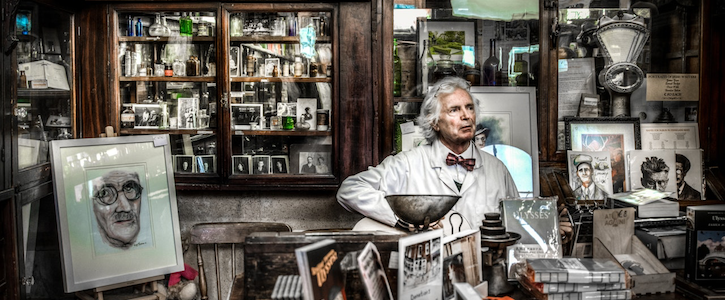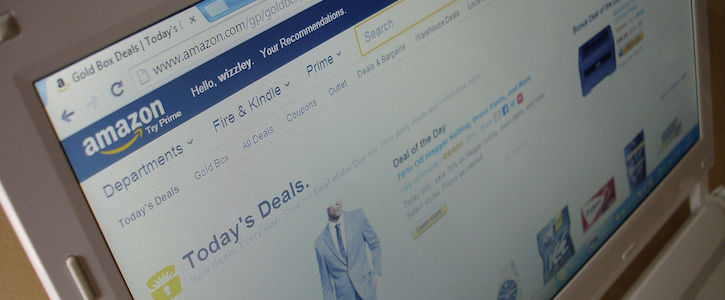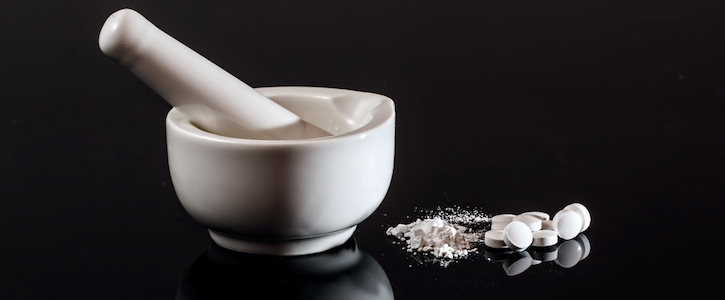The Job Market for Pharmacists Is Rapidly Changing, and It's Not Because of Silicon Valley
Amazon’s purchase of PillPack made insiders wonder whether traditional pharmacies were at risk. But pharmacists are used to disruption.

Will Amazon disrupt the pharmacy?
Femi Felix-Ukwu never intended to become a pharmacist. Felix-Ukwu, a pediatric clinical pharmacist at Connecticut Children’s Medical Center, grew up in Washington D.C., the son of a community pharmacist mother and a lawyer father. While attending Emory University in Atlanta, he figured he’d become a doctor but dropped the idea as he progressed in his premed studies. Being a doctor interested him, but he didn’t have the patience to weather four years of medical school and then several more in far-flung residencies. So, after graduating, he held down a series of odd jobs, teaching biology and working the front desk of a gym, before finally figuring out his calling.
“[Pharmacist] seemed like a respectable position,” Felix-Ukwu says. “You get to wear a fancy lab coat. It seemed like a career that I could be proud to say, ‘I’m this or I’m that.’ When you talk about whatever you do for a living, [being a pharmacist] has a nice ring to it.”
>> LISTEN: Amazon’s Path of Disruption
In 2008 Felix-Ukwu started the first year of his Pharm.D program at Texas Southern University’s pharmacy school, his mother’s alma mater. At the time, he was one of many pharmacy school enrollees who viewed the career as safe but burgeoning, complete with thousand-dollar signing bonuses and plentiful employment opportunities. But by graduation in 2012, Felix-Ukwu, like many of his peers, felt that his job prospects had dimmed considerably, as sign-on bonuses had disappeared and competition for full-time jobs grew stiff.
That bleakness for pharmacy school grads and working pharmacists has extended into 2018, especially as news hit that Amazon entered the pharmacy fray by buying PillPack in July for nearly $1 billion, prompting a run of headlines that wondered if Amazon would kill many brick-and-mortar pharmacies.
But while the narrative of Silicon Valley’s turning the pharmacy business on its head is convenient, it’s a small player in changing the industry as a whole. The current state of the industry, which has affected employment prospects for current and future pharmacists, has been in the making for a long time. And despite the gloomy outlook, the pharmacists with whom we spoke mostly expressed optimism about the future of their careers, Amazon or no Amazon.
What Does Amazon’s PillPack Purchase Mean?
A little more than a month after Amazon acquired PillPack, Business Insider ran a review with a headline that spouted the conventional wisdom surrounding the Silicon Valley giant’s purchase: “We tried PillPack, the pharmacy startup that Amazon acquired for $1 billion, and we can see why it has big pharmacies terrified.” The article touted PillPack’s functionality and ease of use, particularly its intuitive ordering process and self-sorting prescription technology. The message was clear: Amazon’s acquisition was a game changer and signaled a major shift in how traditional pharmacies and pharmacists would have to do business if they were to survive.
Although the particulars of PillPack’s business model are novel (self-sorting prescriptions, distribution licenses in nearly every U.S. state), the general concept (online or mail-order pharmacy) isn’t.
“The other bigger chains out there have been doing mail order for years,” American Pharmacists Association CEO Thomas Menighan explains. “Amazon is huge, and they’re growing, you know. Can they disrupt healthcare? Maybe. Mail order is nothing new, so how we deliver care, I think, is the trick.”
If there’s a person who’s witnessed the ebb and flow of pharmacies and pharmacists over the decades, it’s Menighan.

The Amazon-PillPack move could spur more innovation in the pharmacy.
The West Virginia native grew up in the Ohio River Valley, where chemical plants proliferated. His friend’s father was a chemist at a local plant, so he and his friend got their hands on several chemistry sets, which allowed them to create gunpowder. His interest in mixing chemicals led Menighan to working at his father’s friend’s pharmacy, where he shaved ice for the soda fountain. That job inspired him to attend pharmacy school.
Since then, Menighan has held many different pharmacy roles, from community pharmacist to home infusion and specialty practice owner. He’s also witnessed the evolution of the role of the pharmacist, observing how the occupation went from having little patient interaction (so as to prevent undue influence over the physician-patient relationship) to requiring high levels of involvement.
When it comes to Amazon’s acquisition of PillPack, Menighan’s bullish, saying, “I think they will force others to try new things, and that’s where innovation happens.” However, he says that industrywide disruption has been happening for years, possibly decades.
>> READ: With $1B Purchase of PillPack, Amazon Fulfills Its Pharmacy Destiny
“Certainly, the development of chain pharmacy began to change things,” he says. “The best practices of independent community pharmacies began to get spooled up and scaled, but they found other ways to provide good care. Then mail order came along, and that made many people think and respond to the market differently .... Then third-party plans began, Medicaid began to pay for prescriptions, and insurance companies began paying to provide prescription benefits to folks.”
For their part, major brick-and-mortar chains have begun to consider their futures in response to the increasing viability of online pharmacies like PillPack.
Walgreens, when contacted by Healthcare Analytics News™, pointed to the transcript of its most recent earnings call, which outlined the chain’s future plans. Although the company closed 131 stores in pursuit of optimization, the chain championed its partnership with Humana to bring primary-care services to certain stores in the Kansas City area, thus beginning a potential diversification of its medical services. And when pressed about Amazon’s acquisition of PillPack, Walgreens Boots Alliance Inc. Co-Chief Operating Officer Alexander Gourlay pointed out that the chain already offers the exact service that PillPack provides.
CVS also provides a PillPack-like service to its customers. When asked via e-mail about the chain’s thoughts about Amazon’s acquisition, Erin Pensa, a spokesperson for the company, mentioned that CVS Pharmacy already offers prescription delivery in one to two days and multidose packaging. “The packs are clearly labeled with [the] prescriber’s instructions and medications,” Pensa says. “[They can] be mailed directly to the patient’s home or to their local CVS Pharmacy.”
Whether or not Walgreens, CVS and other major pharmacy chains continue to compete with PillPack in the long term remains to be seen, but it doesn’t appear that a short- or midterm collapse is on the horizon. These chains and their pharmacists might even find reason for long-term optimism, considering their role is far greater than that of pill dispenser.
“You can maybe deliver medicines a little faster than we’re already doing,” Menighan says, “[but] I’ve sat down with a lot of folks who really wanted to just come and talk. It was one thing to get their medicine through the mail, and many of my patients did because they belonged to AARP, but they’d still come in and talk with me.”

For aspiring pharmacists, the job outlook is much different than it once was.
Tech Is Changing the Pharmacy
Despite the belief that PillPack probably won’t change the industry overnight, pharmacists are still gloomy. Felix-Ukwu is hesitant to advocate pursuing a career in pharmacy to prospective students. For him, the threat to current and future pharmacists isn’t PillPack, and it’s not necessarily technology. Instead, he and several other pharmacists with whom we spoke see the proliferation of pharmacy schools and their graduates as the more pressing threat. He saw this situation affect his classmates time and again.
“A lot of time when you’re a pharmacy intern, [you work] every other weekend…, [and for] a lot of pharmacy interns, those opportunities would be their [first] job offers,” he explains. “But a lot of my classmates who were pharmacy interns at Walgreens all of a sudden had to move away to get jobs because Walgreens didn’t have openings. The market was already saturated by graduates who graduated the year before us. A lot of us would have conversations: This isn’t the narrative we heard.”
A 2014 study by the National Institutes of Health shows that an explosion in the number of American Association of Colleges of Pharmacy (AACP) schools occurred about a decade ago. According to our sister publication Pharmacy Times®, four new pharmacy schools opened per year from 2005 to 2012, and the AACP says there are now 142 member institutions.
>> READ: What Prime Day Genetic Testing Deals Say About Healthcare’s Future
Consequently, the number of pharmacists has blossomed. The Pharmacy Times® report states that yearly Pharm.D graduates grew from 7,000 to 13,000 between 2000 and 2013, while the number of pharmacist jobs available tapered off in 2010 after a decade of growth. All of this occurred amid a pharmacy school tuition increase of 54 percent, leaving graduates who couldn’t find work with large amounts of debt (over $100,000 worth) and few job prospects.
For clinical pharmacists like Felix-Ukwu and Tara Fallah, who’s a clinical pharmacy specialist in lung transplants at the Hospital of the University of Pennsylvania, this general job squeeze has heightened the stakes for getting into hospital pharmacy. Fallah attained her Pharm.D from the University of Cincinnati and then continued her training by securing a PGY-1 residency and then a PGY-2 residency, with a specialization in organ transplants. Unlike her peers who went into retail pharmacy, her love of the specialty outweighed the quest to make money quickly.
“Right now, there’s really no financial incentive to do [it],” she says. “The gap is narrowing, but retail pharmacists do make slightly more than hospital pharmacists do or about the same. You have to be self-motivated.”
Felix-Ukwu also thinks that automation, especially as it relates to the dispensing of medications, could consolidate positions in both retail and hospital settings. More specifically, he believes central fill, a brick-and-mortar pharmacy practice wherein a chain uses centralized locations to process prescriptions, poses a risk to jobs. He and his friends saw central fill decrease full-time employment in retail settings when they graduated, transferring formerly secure salaried jobs to high-paying hourly gigs.
“Pharmacists in my group chat have mixed views on central fill,” he says. “Just from a pragmatic standpoint, you’re moving that one person from the store to the warehouse. Like, we’re not losing jobs, but I think the literature shows that by moving them to the assembly line, you can cut back total hours. When you add up the hours of the pharmacist in the warehouse versus the pharmacist on location, it removes some of the human element.”
But Is Tech Disrupting the Pharmacy?
Will Amazon or any other Silicon Valley player disrupt the pharmacy and, consequently, pharmacists’ lives? The threat is still small. In a March 2018 article, Vox’s Dylan Scott outlines that while the titans of the tech industry, including Apple, Google and Amazon, would love to change the healthcare market, their efforts have gained little to no traction because of “the complexity, opacity and sheer scale” of the healthcare industry. And as a 2017 CNBC article points out, the moves that Silicon Valley has successfully made haven’t brought forth the sea change that the tech industry promises, because they’ve been in areas where they didn’t encounter regulatory hurdles.
Of course, technology has already affected pharmacists, but in the cases of Felix-Ukwu and Fallah, both consider themselves and their peers indispensable, as they’ve embraced technological change and diversified their skill sets to go beyond simply dispensing medications.
“Given how much technology we have in place now, we’ve been able to pull away a lot from that traditional role,” Fallah says. “Instead, my job is focused on the actual medication therapy, working with the team to choose medications, making sure the dose is optimized, making sure it matches the appropriate indication.”
At the end of the day, Felix-Ukwu believes being mindful of these shifts makes a complete pharmacist, one who can succeed in any facet of the industry. But he also says one other factor can be a pharmacist’s saving grace: It’s hard to disrupt people.
“If you’re a solid worker and you have people skills, then you’ll never be able to [be replaced],” he says. “The finesse in how I speak to people, doctors, residents, nurses, there are certain things with my personality that I feel very comfortable knowing that I’m always going to have a job. If you’re adaptable, you should be OK.”
Get the best insights in healthcare analytics directly to your inbox.
Related
Jeff Bezos’s VC Arm Contributes to Mindstrong’s $15M Round
Amazon’s Alexa Really Isn’t Ready for Healthcare
CVS Looks to Lower Patient Drug Costs with New Digital Tools
Podcast: Adoption of Healthcare Tech in the Age of COVID-19 with Dr Kaveh Safavi
June 22nd 2021Kaveh Safavi, MD, JD, global health lead of Accenture Health, discusses how the pandemic influenced the speed at which healthcare organizations adopted new technologies and how this adoption is impacting patient care.